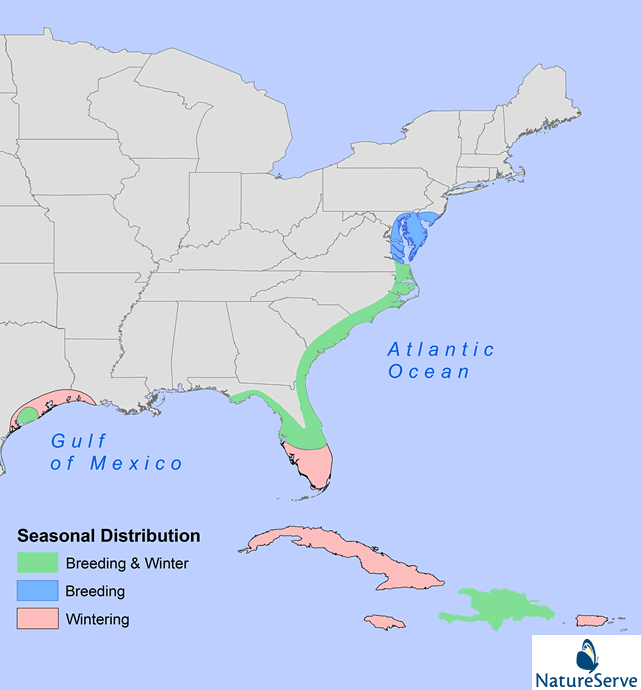Black Rail Population Status
Black rail populations have been declining in the eastern United States for over a century resulting in a retraction of its breeding range, an overall reduction in the number of breeding locations within its core range, and a loss of individuals within historic strongholds. Over the past 10-20 years, some reports indicate that populations have declined 75% or greater and have become dangerously low. Recent evidence suggests that black rails may only breed in a dozen or fewer places in each state along the Atlantic and Gulf coasts.
The outlook for this species is uncertain. Within the Atlantic and Gulf coastal regions, black rails occupy habitats that are vulnerable to land-use change or sensitive to changes in climate. Because of the low elevational position within the landscape, salt marshes will be among the first habitats consumed by sea-level rise. The extensive patches of high marsh required for breeding are projected to be lost or converted to low marsh. Moreover, the position of black rail habitats along the marsh-upland interface makes this species particularly vulnerable to terrestrial nest predators.
Table 1 – General status of the Black Rail within the breeding range of the Atlantic and Gulf coastal states – Table will be updated as more information becomes summarized.
| State (North to South) | # of Breeding Locations | Breeding Population Trend |
| Connecticut | 0 | Likely Extirpated |
| New York | 1 | Possibly Extirpated |
| Delaware | < 5 | Declining |
| Pennsylvania | Unknown | Unknown |
| New Jersey | < 10 | Declining |
| Maryland | < 20 | Declining |
| Virginia | < 20 | Declining |
| North Carolina | < 20 | Declining |
| South Carolina | < 5 | Unknown |
| Georgia | < 5 | Unknown |
| Florida | < 20 | Declining |
| Texas | < 20 | Possibly Declining |
Distribution & Range
The eastern black rail (Laterallus jamaicensis jamaicensis) is one of two subspecies that breed in North America. The other subspecies, the California black rail (Laterallus jamaicensis coturniculus), breeds in California and Arizona. The California black rail and an inland population of the eastern black rail in Kansas are geographically separated from Atlantic and Gulf coast concentrations.
Eastern Black Rail within Atlantic and Gulf Coastal Range
Breeding – Black rails breed from New York to Florida along the Atlantic Coast and in Florida and Texas along the Gulf coast. Historically, the northern edge of this breeding range may have once extended as far as Massachusetts but contracted south to New York sometime in the early twentieth century.
Winter – Black rails spend the winter along Atlantic coasts from New Jersey to Florida and along the Gulf Coast from Florida to Texas. Breeding populations of the eastern United States may also winter in Cuba and the West Indies.
Figure 1 – Distribution of the Black Rail along the Atlantic and Gulf coasts

Black rail distribution based on Digital Distribution Maps of Birds of the Western Hemisphere as provided by NatureServe in collaboration with Robert Ridgely, James Zook, The Nature Conservancy Migratory Bird Program, Conservation, International Center for Applied Biodiversity Science, World Wildlife Fund US, and Environment Canada WILDSPACE. (Kansas black rail population is not depicted)
Habitats
Salt marsh – Black rails occupy the upper zone of tidal salt marshes known as the high marsh. The high marsh is only inundated during extreme high tide events and dominated over most of the Atlantic coast by plants such as salt meadow hay (Spartina patens), saltgrass (Distichlis spicata), and often interspersed with shrubs such as marsh elder (Iva frutescens) or saltbush (Baccharis hamilifolia). In general, the character of the high marsh is a short grassy savannah. The high marsh generally forms as isolated hummocks in elevated portions within marshes or more frequently along the upland-marsh edge. The ecotone between the upland and marsh can sometimes include stunted pine trees (Pinus spp.) and red cedar (Juniperus virginiana). Additional features of black rail habitats can be the presence of salt pannes (higher saline patches dominated by Salicornia spp.) and patches of needlerushes (Juncus spp.). In Florida, the high marsh is often composed of cordgrass (Spartina bakeri), sawgrass (Cladium jamaicensis) and interspersed with cabbage palms (Sabal palmetto), silverling (Baccharis angustifolia) and small trees.
Non-tidal Wetlands – Black rails are rarely found inland over most of the Atlantic and Gulf coasts except in central Florida. In Florida, inland habitats are often hummocks within freshwater marshes composed of a mix of rushes, sedges, and interspersed with cabbage palms and small trees.
